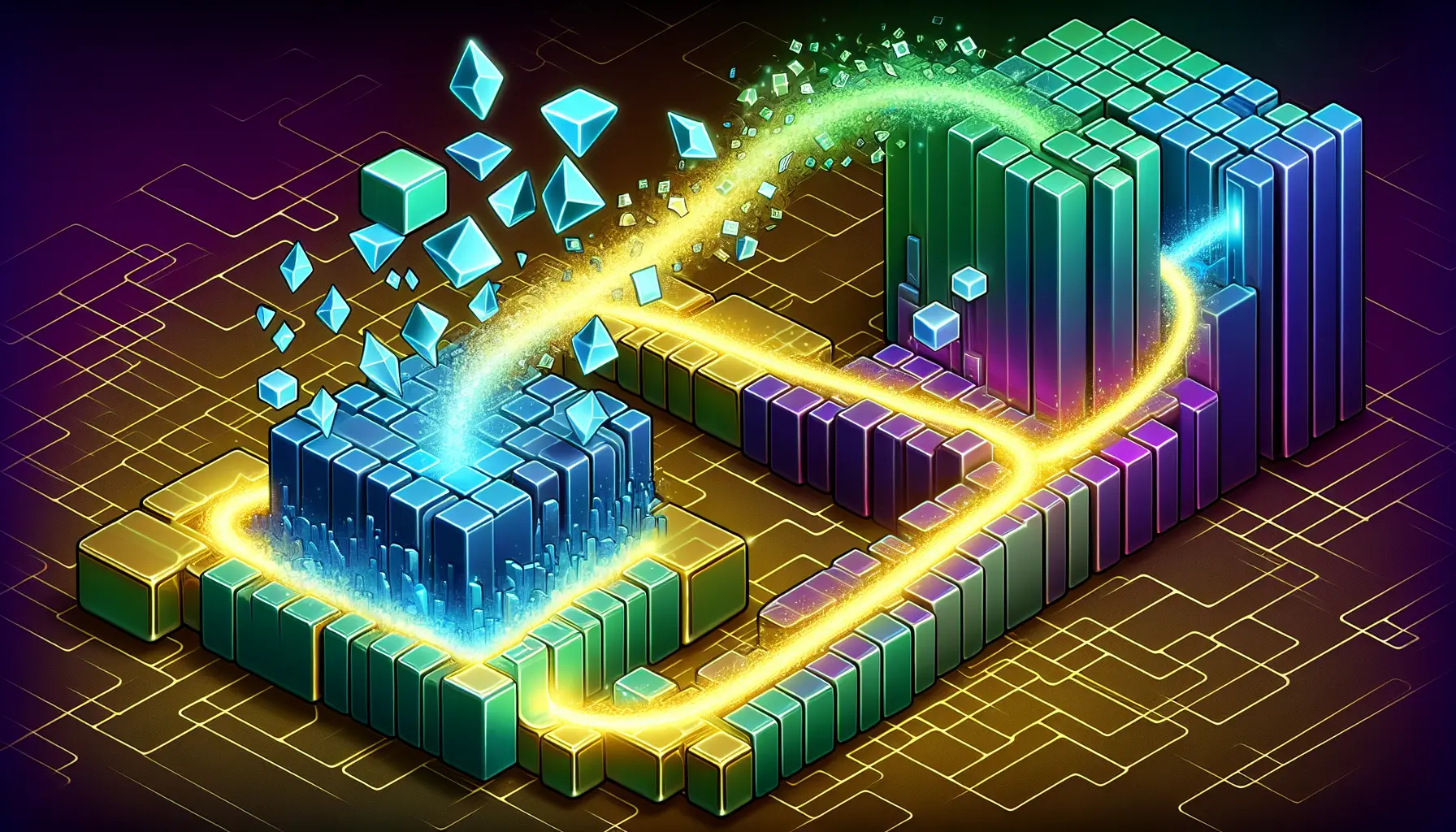When diving into the innovative realm of blockchain, a key question arises: what does the block in the blockchain consist of? A block is not a mere digital container; it’s a sophisticated structure holding a timestamped batch of recent transactions together, a unique cryptographic hash, and a reference to the previous block’s hash, creating an unalterable chain of data integrity.
But that’s just the surface. This article will guide you through the intricate details that give each block in the blockchain its strength and stability, from hashes and nonces to the Merkle tree and linking public keys back to previous blocks in the blockchain.
Key Takeaways
- A block in the blockchain securely records transaction data, includes a link to the previous block, and its header contains vital metadata such as the timestamp, previous block hash, and a unique nonce, ensuring chronological integrity and resistance to alterations.
- Blockchain transactions go from pending to confirmed status through the mempool, miners’ verification, and broadcasting across the network, culminating in being sealed in a block, perpetuating the blockchain’s historical record.
- Blocks may also contain smart contracts, network instructions, or metadata, with variations in block structure and consensus mechanisms across different cryptocurrencies influencing their network’s security, scalability, and speed.
A block in the blockchain consists of several key components that enable blockchain technology’s secure and decentralized functioning. Let’s break down these components and present them in a featured table for clarity:
- Block Header: This contains metadata about the block and several vital elements.
- Transaction List: This section contains all the transactions included in the block.
Components of a Blockchain Block
| Component | Description |
|---|---|
| Block Number | The unique identifier of the block within the blockchain is often known as the “height” of the block. |
| Previous Block Hash | A cryptographic hash of the previous block in the chain. This ensures the integrity of the blockchain by linking the blocks sequentially. |
| Timestamp | The timestamp records when the block was created. This helps maintain the chronological order of blocks. |
| Nonce | A nonce (“number only used once”) is used in proof-of-work systems to find a hash below a target value, which secures the network. |
| Transaction Merkle Root | A hash of all the transactions in the block, arranged in a Merkle tree. This structure allows for efficient and secure verification of transaction contents. |
| Difficulty Target | This defines the difficulty level of the proof-of-work algorithm for mining a new block. |
| Version | Indicates the version of the blockchain protocol used to create the block. |
| Transaction List | A detailed list of all transactions included in the block, each of which is a record of cryptocurrency transfer between addresses. |
This structure ensures that blocks are tamper-proof and establishes a trustless blockchain network consensus. Each component is critical in maintaining the blockchain’s integrity and security.
Unpacking the Blockchain Block

Envision the blockchain as an ever-growing library of digital blocks, each a container of transactional history bound together in an unbreakable chain. A block in a blockchain is the fundamental unit, a digital ledger page that, when sealed, becomes immutable—a testament to the trustless nature of the technology. It’s a permanent record that, once etched into the digital fabric of the network, remains unalterable and eternally verifiable.
Within these blocks lie the essence of blockchain’s promise:
- A timestamped record of transactions
- Each block is a thread in the grand tapestry of the distributed ledger
- Not just a record, a declaration of transparency and security
- A block represents the collective agreement of the network’s participants
- Serves as the foundation upon which the entire system is built
We will now delve into the structure of these multiple blocks to understand their role within the blockchain network.
Anatomy of a Block Header

The block header is the beating heart of a block, encapsulating the private key metadata that guides the blockchain to send Bitcoin’s pulse. It’s a composite of critical information to send Bitcoin around, including:
- A precise timestamp marking the block’s creation
- The previous block hash, which serves as a reference to the previous block’s header in the chain
- A cryptographic nonce—a unique number of miners adjust in their quest to discover a qualifying block hash
- This 64-digit hexadecimal number hash is the fruit of the SHA256 algorithm, a digital fingerprint that locks down the block’s identity within the blockchain ledger.
But the block header does more than tag and identify; it’s a guardian of the blockchain’s chronological integrity. The block header stands as a sentinel, with its block hash and nonce forming the cryptographic keys that unlock the next phase in the blockchain’s relentless progression. The block header includes two blocks:
- The version number of the software
- The hash of the previous block
- The Merkle root of all the transactions in the block
- The timestamp of when the block was created
- The difficulty target for mining the block
- The nonce, which is a random number used in the mining process
The timestamp ensures that each block is anchored to the last block in the same block of time, providing the rhythm for the ledger’s immutable march.
Transaction Data Inside a Block

A deeper exploration into the block’s body reveals transaction data, effectively forming a ledger that tracks cryptocurrency movement between participants. Each transaction holds the secrets of sender and receiver addresses, the amount transferred, and the digital signatures that seal the deal.
This data is meticulously assembled, with the coinbase transaction and the miner’s reward sitting proudly at the forefront and leading the parade of transactions within the block.
Before their incorporation in a block, the unconfirmed transactions reside in the mempool and are waiting to be validated. Here, miners or validators sift through this sea of transactions, using their computational prowess to confirm their legitimacy before etching them into the blockchain’s ledger.
Once a block hash is verified, the block’s transaction data becomes a chapter in the grand narrative of the blockchain, an unalterable record of the network’s history.
The Link to the Previous Block

As a chain’s strength lies in its links, the blockchain’s integrity is in the last connection block. Each new block contains the hash of the previous block within its header, a cryptographic nod that binds the present to the past. This link is the blockchain’s spine, a backbone of references that forges a data lineage stretching back to the genesis block—the blockchain’s origin story.
The chain of blocks forms a digital relay race, with each block passing the baton of data integrity to the next block. This unbroken sequence allows the blockchain to act as a single source of truth. This historical record is consistent and resistant to any attempt at falsification. The blockchain stands tall within this framework of linked blocks, a testament to decentralized security and collaborative validation.
The Lifecycle of a Blockchain Transaction
A blockchain transaction traverses through a series of checkpoints, each crucial in transitioning a digital signature from intent to permanent record. It begins with initiating a transaction—when a digital command is set forth to transfer cryptocurrency across the vast expanse of the Bitcoin blockchain network. But before a transaction can claim its place in the blockchain ledger, it must undergo the scrutiny of those who toil in the digital mines—the miners.
These network guardians engage in a meticulous process, verifying transactions against the blockchain’s rules, ensuring that only the truest of transactions are woven into the fabric of data structures in the ledger. Once a transaction is verified, it is added to the blockchain within a new block, a digital seal that marks the end of one journey and the beginning of another.
A cycle of birth, life, and rebirth propels the blockchain forward, a lifecycle that breathes dynamism into the blockchain database’s static data structures.
From Pending to Confirmed: The Transaction Pool

A transaction has to pass through the mempool, the holding area for unvalidated transactions, before it can be confirmed. In this limbo of unconfirmed transactions, they await the miners’ judgment, each vying for attention, hoping to be chosen for the next block’s composition.
Yet, not all transactions are equal in the eyes of the miners; those adorned with higher fees whisper promises of greater rewards, luring miners to prioritize them over their less lucrative peers.
The transaction pool serves as a waiting room and a competitive marketplace where transactions vie for attention and miners act as discerning evaluators.
In this dynamic environment, transactions make their case, hoping to emerge from the pool with the stamp of approval, ready to be permanently recorded on the blockchain.
Verification and Addition to a New Block
Verification, in the context of blockchain, is a critical process where miners confirm the authenticity of each transaction. Adhering to the blockchain’s stringent rules, miners ensure that only the worthy transactions are anointed with validation.
The moment of adding a digital signature to a transaction counter, a new block marks the culmination of this ritual. This ceremonial closure seals the transaction counter within the blockchain’s ledger, forever part of its historical record.
As one block reaches closure, another is born, a canvas ready to be adorned with fresh transactions, each seeking the same fate as its predecessors—to be verified, added, and celebrated as part of the blockchain’s ongoing legacy.
This cycle of verification and the addition of previous blocks to recent transactions is the heartbeat of the blockchain. This rhythm sustains the network’s vitality and ensures the ledger’s perpetual growth.
Broadcasting to the Network
Upon being signed with a cryptographic seal, a transaction is ready to be broadcast across the expansive network of connected computers. The mempool serves as the launchpad for this broadcast, a forum where transactions are displayed for all to see, awaiting the miners’ touch to transform them from aspirations to certainties.
The miner who successfully solves the cryptographic puzzle sends forth a public and private key for the new block into the blockchain network, a digital declaration that beckons confirmation from the collective.
This broadcasting is not the end but a call for consensus, an invitation for the network to come together and agree that the block, with its payload block number of transactions, is indeed valid and worthy of being added to the ledger.
The blockchain’s communication channels buzz with activity as the network undergoes the process of multiple confirmations, solidifying the transaction’s status and guarding against the specter of reversibility. Through this intricate dance of broadcast and confirmation, the blockchain maintains a symphony of synchronization, an entire network of connected computers moving in unison toward a shared truth.
Mining: The Engine Behind New Blocks
In blockchain, mining is the process that converts digital effort into value, underpinning the creation of new blocks. This engine of progress involves a trifecta of tasks: validating transactions, solving cryptographic problems, and, ultimately, adding new blocks to the blockchain’s ever-lengthening chain.
Miners engage in a high-stakes competition, wielding their computational power in a race to uncover the cryptographic hash that will open the doors to blockchain rewards.
The formation of mining pools exemplifies the collaborative spirit of the blockchain community, where miners amalgamate their resources to enhance their chances of success, sharing in the bounty of their collective labor. The blockchain network is fortified through this mining pools’ mechanism, and each new block is a testament to the security measures that protect this revolutionary technology from the forces of disorder and fraud.
Solving the Complex Mathematical Problem
Mining a new block is similar to solving a complex puzzle, requiring both computational power and a bit of luck. Sophisticated hardware and software combine in an intricate ballet, generating cryptographic hashes that must meet the stringent criteria set by the network’s difficulty target. The target hash is a gatekeeper, challenging miners to produce a block containing a hash equal to or less than its value, a virtual seal of approval for adding a new block.
This race to solve the complex mathematical problem is fiercely competitive, a testament to blockchain’s revolutionary technology. Miners from around the globe pit their computational power against one another, each seeking the honor of proposing the next block and reaping the rewards that come with it. It’s a digital battle of wits, where the victor earns the right to inscribe their success into the annals of blockchain history.
The Block Reward Incentive
The appeal of mining lies not only in the achievement of solving the puzzle but also in the tangible rewards accompanying it. The blockchain network bestows successful miners a block reward, a bounty of cryptocurrency that serves as a financial incentive for their crucial role in maintaining the ledger’s integrity.
This reward, known to halve at regular intervals, ensures a steadily decreasing supply of new coins, a deflationary mechanism that imbues the currency with scarcity and value.
Beyond the block reward, miners also reap transaction fees gleaned from the transactions they validate and include within their mined blocks.
These fees represent an additional incentive, a tip for securing the blockchain and facilitating the seamless transfer of digital wealth. It’s a system that balances reward with responsibility, motivating miners to persist in sending Bitcoin and uphold the blockchain’s sanctity.
Ensuring Network Security Through Consensus Mechanisms
The blockchain’s integrity is underpinned by its consensus mechanisms, which ensure that all nodes in the network agree on a single, unaltered version of the truth. These mechanisms are the glue that holds the blockchain network together, synchronizing each new block across countless full nodes to maintain a consistent and secure ledger.
The strength of the blockchain lies not in any central authority but in the distributed consensus that emerges from its participants, a collective fortress safeguarding the network.
Each blockchain utilizes a unique consensus mechanism, each with a distinct strategy for ensuring network security. Ethereum, for instance, uses a proof-of-stake system that randomly selects validators to propose new blocks, incentivizing them with rewards for their contributions and penalizing them for any breaches of trust.
These mechanisms are not mere protocols; they are the very essence of the blockchain’s promise—a decentralized system that is resilient, transparent, and immutable.
Beyond the Basics: Additional Block Elements
A blockchain block is more than just a container for transactions; it also houses multiple elements that fulfill various functions within the blockchain system. These elements can include scripts or programmable instructions, which enable the execution of complex smart contracts on platforms like Ethereum, extending the blockchain’s utility far beyond simple financial transactions.
Additionally, blocks may harbor network instructions or messages crucial for the operation of network-wide protocols, acting as conduits for the coordination and governance of the blockchain itself.
Moreover, blocks can contain metadata that provides context to their creation and origin, such as other data, such as the version number of the blockchain software or notes from the block’s validator. Other elements within a block are crucial for the consensus mechanisms that keep all network participants on the same page, ensuring the blockchain maintains a unified and tamper-proof ledger.
As we explore these additional block elements, we gain a deeper understanding of the blockchain’s complexity and the rich functionality that it can support.
The Role of the Merkle Tree in Blockchain Blocks
The Merkle tree’s innovative structure reinforces a blockchain block’s integrity. This cryptographic tool summarizes all transactions in a block, creating a comprehensive and verifiable digital fingerprint of the block’s contents.
By organizing transaction hashes in a binary tree format and hashing them iteratively up the tree, each level becoming a hash of its child nodes, the Merkle tree culminates in the Merkle root. This single hash is a sentinel for the entire block’s data integrity.
The practicality of the Merkle tree lies in its ability to enable swift and secure verification of block contents. With just the Merkle root and a small amount of additional data, one can confirm the inclusion of a transaction within a block without needing to review every single transaction it contains.
This efficient verification process is a cornerstone of blockchain technology, ensuring the fidelity of the blockchain database and enabling trust in the blockchain ledger’s historical record.
Smart Contracts and Their Storage in Blocks
Smart contracts have transformed the way we view agreements and transactions by automating enforcement and eliminating the need for intermediaries. These self-executing contracts, with terms directly written into lines of code, are stored within blockchain blocks, particularly on the Ethereum blockchain.
Ethereum, unlike Bitcoin, is designed to be a versatile platform capable of much more than recording financial transactions. It supports decentralized applications and hosts smart contracts, which enable a vast array of use cases from:
- finance
- logistics
- supply chain management
- voting systems
- identity verification
- decentralized exchanges
And many more.
The storage of smart contracts in blocks solidifies their terms in the permanent store of the blockchain ledger, with the data stored securely. Once added to the blockchain, the terms are executed according to the coded conditions, and the contract’s outcomes are immutably and permanently recorded. This innovation has opened up new possibilities for trustless interactions, reducing the potential for disputes and increasing efficiency across various sectors.
As we continue to witness the growth of the blockchain, the significance of smart contracts, more transactions, and their integration into block data is likely to become increasingly prominent.
The Significance of Block Size and Its Impact
The debate surrounding block size is crucial within the blockchain community, as it has implications that directly impact the effectiveness of the technology.
Block size, determining how many transactions can be housed within a single block, directly influences the speed at which transactions are processed and the scalability of the network. Finding the optimal block size is a balancing act, weighing the need for rapid transaction processing and ample scalability against the essential requirements of network health and decentralization.
With its 1 MB Bitcoin block size limit, Bitcoin has faced contention, with some advocating for larger blocks to enhance the Bitcoin network’s capacity. In contrast, others argue that smaller blocks are critical for preventing centralization and maintaining robust security.
As the Bitcoin blockchain size increases, larger block sizes can lead to increased centralization, as they require more resources to process, potentially marginalizing individual and small-scale miners.
Ethereum takes a different approach, choosing not to enforce a strict block size limit, reflecting blockchain networks’ differing philosophies and objectives regarding scalability and network management.
Exploring Variations Across Different Blockchains
The blockchain technology landscape is varied and intricate, with each network specifically designed to fulfill particular needs and objectives. Variations across blockchains are evident in their block structures, consensus mechanisms, and block times, reflecting the networks’ unique design philosophies and operational requirements.
These differences are not arbitrary; they are the product of intentional choices made by developers to optimize each blockchain for its intended purpose, whether it be the secure transfer of value, the execution of complex smart contracts, or the support of high-speed transactions.
We appreciate blockchain technology’s ingenuity and adaptability as we explore these variations. From Bitcoin’s focus on security and immutability to Ethereum’s emphasis on flexibility and programmability, each blockchain presents a different facet of the technology’s potential.
Understanding these differences is essential to grasp how the blockchain works and the vast applications it can support, from the Bitcoin blockchain’s financial transactions to the Ethereum blockchain’s decentralized applications.
Differences in Block Structure Between Cryptocurrencies
The distinctions in block structure between Bitcoin and Ethereum showcase the adaptability of blockchain technology. Bitcoin uses the SHA-256 hashing algorithm, which aligns with its proof-of-work consensus mechanism and emphasis on security. Its block structure is ideally suited to support this mechanism, ensuring that adding new blocks remains robust and resistant to attack.
On the other hand, Ethereum’s current block amount structure has been designed to accommodate its transition to a proof-of-stake consensus mechanism as part of the Ethereum 2.0 upgrade, which aims to improve scalability and reduce energy consumption. These structural variations are not merely technical details; they represent different approaches to solving the challenges inherent in maintaining a decentralized ledger.
The choice of hashing algorithm, block validation method, and overall block design are critical components that define a cryptocurrency blockchain’s capabilities and limitations. As the cryptocurrency blockchain and ecosystem evolve, these structural differences will play a pivotal role in shaping the future of cryptocurrency mining and blockchain.
Unique Consensus Mechanisms in Action
Consensus mechanisms are the cornerstone of blockchain technology, ensuring all participants agree about the ledger’s state. While Bitcoin relies on the energy-intensive process of proof of work, requiring miners to solve complex mathematical puzzles, Ethereum has paved the way for a less resource-hungry alternative with its proof-of-stake mechanism, where validators stake their tokens to secure the network.
These mechanisms are about achieving consensus and aligning incentives, ensuring that those who contribute to the network’s security are rewarded for their efforts.
Innovative consensus mechanisms such as proof of history, elapsed time, and delegated proof of stake aim to address some of the shortcomings of traditional methods, such as high energy consumption and limited scalability. These novel approaches are experiments in governance and efficiency, pushing the boundaries of what blockchain networks can achieve.
As blockchains continue to diversify, exploring different consensus mechanisms will remain a key driver of innovation and adaptation within the industry.
How Does the Blockchain Maintain a Historical Record?
One of blockchain’s most defining and significant features is its ability to preserve a historical record. By design, the blockchain is an immutable ledger, ensuring that it becomes virtually impossible to alter once data has been recorded.
This immutability is achieved through the decentralized structure of the blockchain, which distributes copies of the ledger across a network of participants rather than relying on a single central authority.
Each addition to the blockchain is a commitment to the integrity of the historical record, with every transaction timestamped and verified by the network’s participants, making any fraudulent activity noticeable but incredibly challenging to execute without immediate detection.
Blockchain’s transparent audit trail provides clear data provenance, enabling independent verification of the entire data’s origin and history. This level of transparency and accountability is unparalleled in traditional record-keeping systems, where centralization and opaque processes can often obscure the true lineage of data.
The blockchain, by contrast, offers:
- A chronological, transparent, and decentralized ledger
- A bastion of trust in the digital age
- Preservation of historical records with integrity for posterity.
Summary
We have journeyed through the digital terrain of the blockchain, uncovering the intricate details of what makes a block and its profound impact on the network’s operation.
From the structured anatomy of a block header, the rich transaction data it encompasses, to the cryptographic links that bind the blocks into a chain, we have seen how the blockchain secures and immortalizes the flow of digital information. With its complex mathematical problems and rewarding incentives, the mining process acts as the heartbeat of the blockchain, driving the addition of new blocks and ensuring the network’s security.
As we explored the diverse landscape of blockchain technology, we discovered the variations in block structures and the different consensus mechanisms and mechanisms, each tailored to the unique needs of other blockchain networks. The blockchain’s role in maintaining a historical record has highlighted its significance in ensuring data integrity and establishing trust in a decentralized environment.
As the blockchain continues to evolve and adapt, it stands as a testament to human ingenuity and the relentless pursuit of a more transparent and secure way to record our digital interactions.
Frequently Asked Questions
What is a block in a blockchain?
A block in a blockchain contains a data structure that permanently records transaction data, timestamps, and a unique hash, forming the foundation of the blockchain’s ledger.
How are transactions added to a blockchain block?
Transactions are added to a blockchain block after being verified by miners or validators and then included in a new block, which is added to the blockchain. This ensures the security and integrity of all the transactions and the whole blockchain.
What is the significance of the block header in a blockchain block?
The block header in a blockchain block is significant because it contains essential metadata, such as timestamps, the hash of the current block amount’s data, the hash of the previous block’s block header amount, and a cryptographic nonce, which are crucial for the security and chronological integrity of the blockchain.
How do different blockchain networks vary in their block structures?
Different blockchain networks vary in their block structures based on their consensus mechanisms and operational needs, such as Bitcoin’s use of SHA-256 for proof-of-work and Ethereum’s support for proof-of-stake.
Why is the blockchain considered an immutable ledger?
The blockchain is considered an immutable ledger because its decentralized structure makes it nearly impossible to alter or move block records or delete recorded data, ensuring tampering with block records is immediately noticeable and virtually impossible without consensus.
Disclaimer: The content on this site should not be considered investment advice. Investing is speculative. When investing, your capital is at risk.







